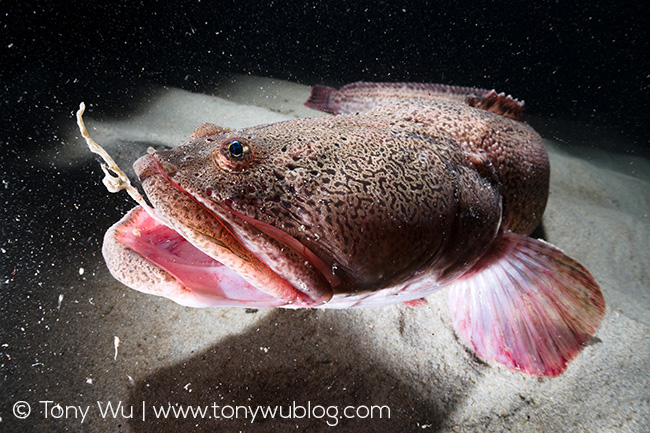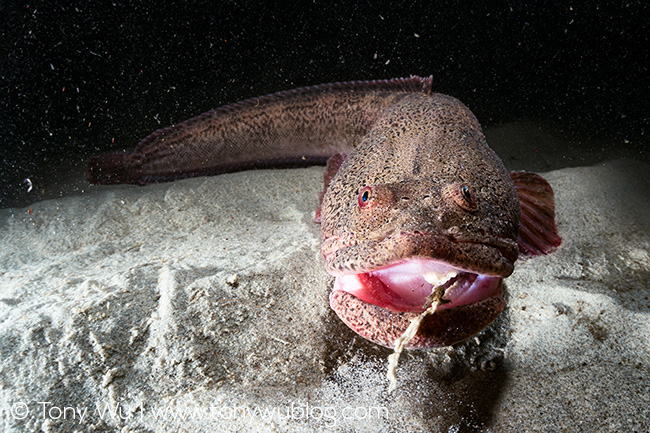Meet Stichaeus grigorjewi, a fish that grows to a length of up to 70cm and lives in the range of 100m to 300m depth in the cold waters of the Northwest Pacific and Okhotsk Sea. It is known as a long shanny, northern blenny, or nagadzuka (ナガヅカ) in Japanese.

Stichaeus grigorjewi is a prickleback, which is a family of fish that comprises around 60 species, all marine. They are slender animals, with low dorsal fins running along the length of their bodies, and have small or nonexistent pelvic fins. The spines of their dorsal fins are spiky, hence the name prickleback.
The eggs of this particular species contain a toxic phospholipid called dinogunellin. Ingesting this substance probably won’t kill you, but doing so would make you major miserable.
To underscore this fact, there are cautionary folk sayings in Japan, roughly translated as: “Even crows won’t eat the eggs,” and “Even flies won’t touch the eggs.” Pretty darn clear if you ask me.
And yet, for whatever reason, four people in northern Japan decided to eat some of the eggs in 2003, thus kindly providing the other 7+ billion of us with empirical evidence of dinogunellin despair without our having to experience it directly. (Spock would have been proud. “The needs of the many outweigh the needs of the few.”)
The four toxin-taste-test volunteers suffered severe symptoms similar to what you’d get with a bad case of food poisoning (nausea, vomiting, diarrhea, fever, dizziness, whacked out pulse, etc.), but they survived.
I wish I could tell you more about this fish, but I’m at a loss. I cannot find much more information.
I looked hard, because I really want to know what that big floppy thing shooting out of its mouth is. Here is a frontal view:

Because of my focus lights, there were many small critters in the water. There were larval shrimps, crabs and probably krill as well, along with bristly worms and other miscellaneous wiggly squirmy thingies determined to photo-bomb and achieve immortality as backscatter in my photos.
It’s difficult to describe exactly what the fish was doing. The best reference I can suggest is to ask you to think of how a chameleon shoots out its tongue. It sort of cranks the spring-loaded mechanism, you sense the building tension, and then “whoosh!” the tongue shoots out and nabs the prey.
In this case, once I grew accustomed to the fish’s body language, I could tell when it was cranking up, so I could anticipate the spring-loaded moment. But unlike a chameleon tongue, the whatever-it-is body part shot forth, spread out, swirled and splatted. As it unfurled, it also branched out. It flopped as well.
It did not move with the precision and purpose of a lethal hunting appendage, but behaved more like a drunken sailor on shore-leave waving a handful of socks to swat flies, with all the grace and fine motor coordination that scenario implies.
I sat there scratching my head (literally a few times because the creepy crawlies were getting to me), trying to work out what the fish was doing.
My conclusion?
No clue.
My first instinct is that the fish may have been grabbing the little things in the water to eat. I did not actually see it ingest anything. But because the stuff in the water was so small, it is possible that the fish successfully caught and ate things that I simply may not have seen.
But it occurred to me that the situation was somewhat non-standard from the fish’s perspective. The reason there were so many little things buzzing around in the water was my lights. The lights attracted stuff. So much stuff that I had to constantly turn the lights off and sit in the dark for a few minutes at a time to clear up the water.
Remember that Stichaeus grigorjewi usually lives in deep water. They come up shallow for reproduction. Down deep, there are no dopey air-breathing divers using light to seed critter-cloud formation. In fact, the density of little animals down deep would be low, wouldn’t it? So using a spring-loaded-floppy-thing-with-a-suboptimal-sense-of-direction to gather food wouldn’t make sense, would it? I don’t know.
But if not for catching/ gathering food, then what function would that tongue (for lack of a better word) serve? Again, I don’t know.
If you know, or if you know someone who might know, please let me know.